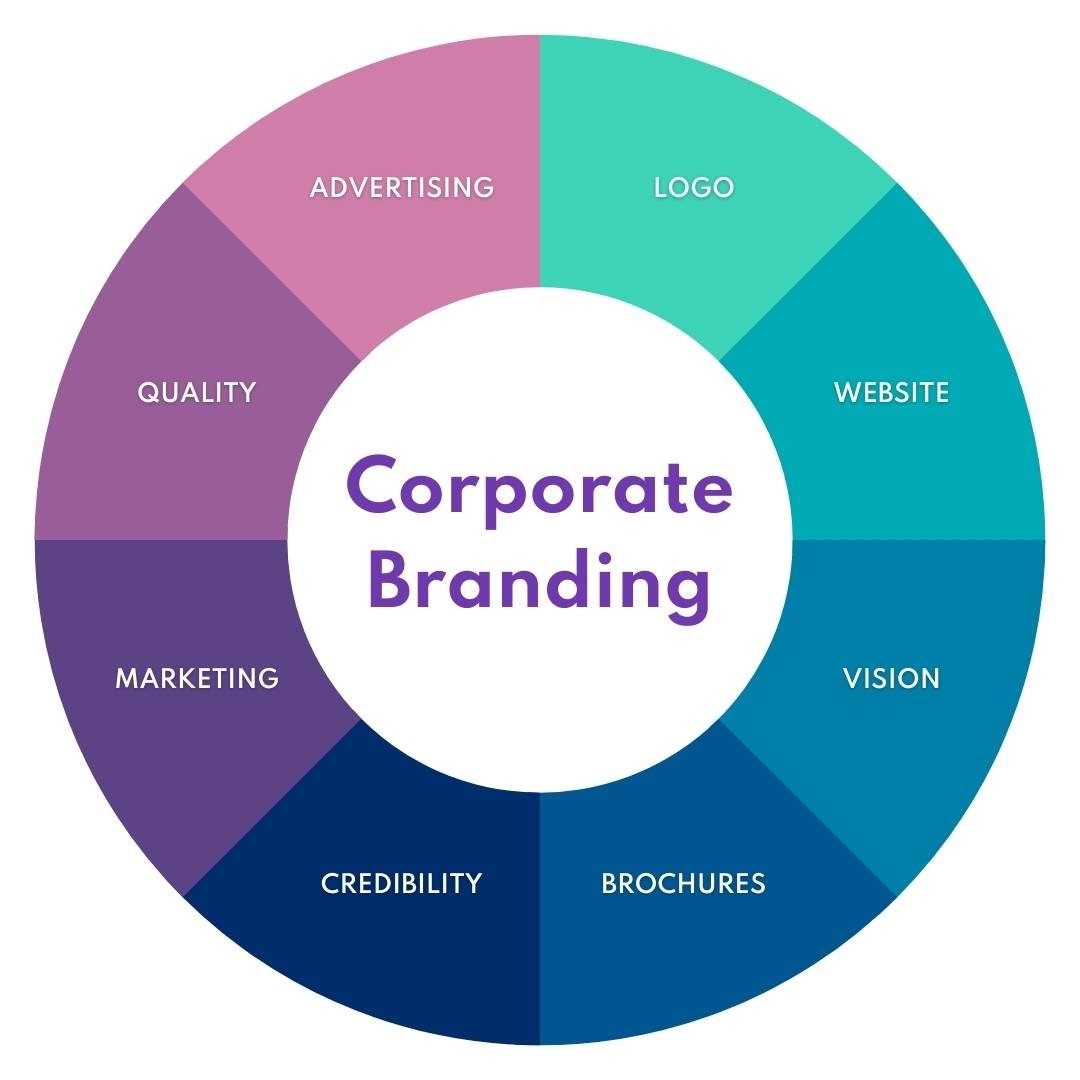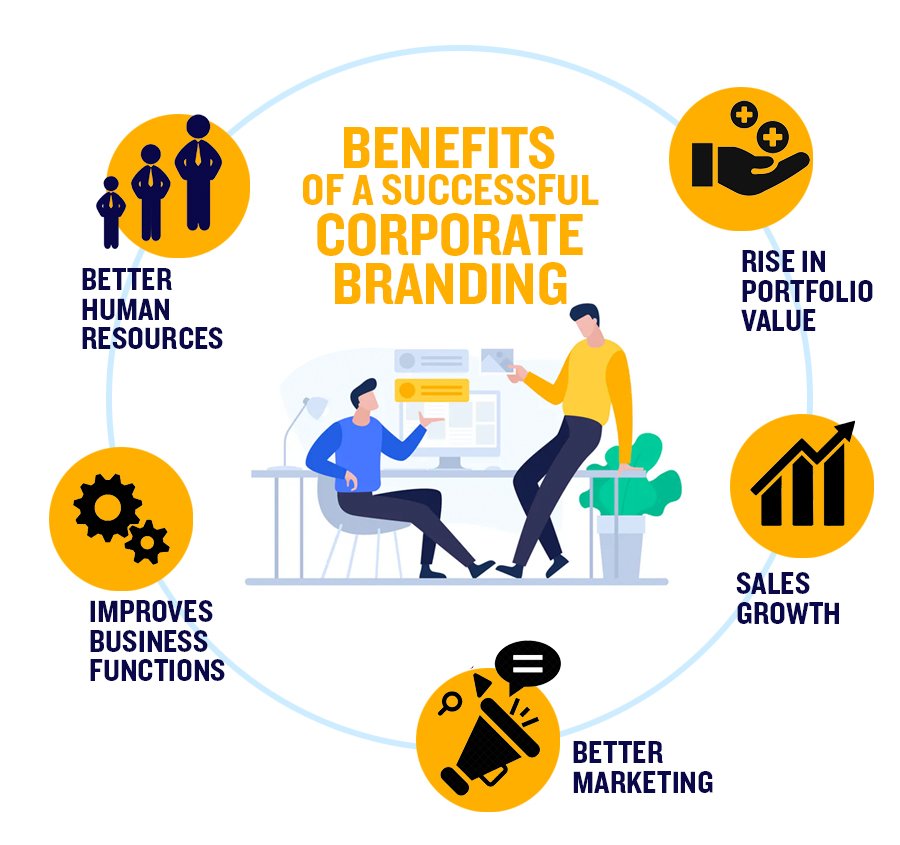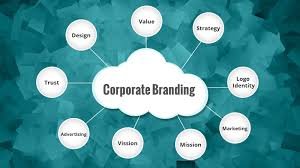Best Corporate Branding
Corporate branding is crucial in establishing a strong and recognizable identity for businesses operating in English speaking countries.
The use of language, tone, and messaging within branding efforts can greatly impact how a company is perceived by its target audience.
Companies that effectively utilize corporate branding techniques are able to build brand awareness, establish loyalty, and ultimately increase their bottom line.
In this blog, we’ll explore the importance of corporate branding in English-speaking regions and provide tips for creating a successful brand strategy that resonates with audiences.
So, if you’re interested in elevating your company’s image in the English-speaking market, read on!

1. What is Corporate Branding and Why is it Important?
Corporate branding is the process of creating a unique and consistent identity for a business organization that defines its qualities, values, and goals. It is more than just creating a logo or a tagline, it is about creating a strong reputation and loyalty among consumers. Why is it important? Here are some reasons:
- It allows you to define the business’s personality, characteristics, values and purpose. By defining these qualities, it helps customers connect with a brand on a more emotional level, leading to brand loyalty and repeat business.
- Corporate branding creates brand awareness. A strong brand is recognizable and memorable, leading to more customers and market share.
- Consistency establishes your company’s presence. It builds trust and credibility with consumers and sets you apart from competitors. A consistent brand also helps customers to remember your business and its offerings.
- A strong corporate brand can change people’s perception of your company. It can help a business stand out from the competition and appeal to new markets, while also generating a sense of pride among employees and stakeholders.
- Successful examples of corporate branding include brands such as Apple, Nike, and Coca-Cola, who have built a reputation for quality, innovation, and unique messaging that resonates with their target audience.
Overall, corporate branding is essential for any business looking to create a strong identity and increase customer loyalty. It can help to establish your presence in the market, create a sense of trust, and generate a positive reputation. By investing in corporate branding efforts, you can create a distinct identity that sets you apart from the competition and helps you to succeed in the long term.
2. Understanding Trademarks and Their Role in Corporate Branding
“10 Reasons Why Trademarks are Vital for Your Corporate Branding Strategy”
- Protect Your Unique Identity: A trademark gives you exclusive ownership of your brand identity, preventing others from using it without your permission.
- Prevent Brand Confusion: By protecting your brand identity, a trademark helps to prevent confusion among customers as they try to identify your products and services.
- Enhance Brand Awareness: A well-chosen trademark can create strong brand awareness, reinforcing customer loyalty and trust in your brand over time.
- Build Your Brand’s Value: A trademark is a valuable asset that can increase your brand’s value over time, contributing to its overall success and profitability.
- Establish Credibility: By having a registered trademark, you can establish credibility and authenticity among customers, as it communicates that your brand is legitimate and reliable.
- Secure Your Online Presence: Trademarks can protect your brand identity online, preventing others from using your brand name or logo in online domains, social media, and other digital outlets.
- Foster Innovation: Trademarks encourage the development of new and innovative products and services, as businesses can be more confident that their unique ideas will be protected.
- International Protection: Trademarks are recognized globally, giving businesses the ability to protect their brand identity in multiple international markets.
- Leverage Brand Loyalty: By protecting your brand identity, you can leverage brand loyalty, creating long-term relationships with customers and ensuring repeat business.
- Stay Ahead of The Competition: A trademark can give your brand a competitive edge in the marketplace, helping you distinguish your products and services from others on the market.
3. Building a Strong Corporate Identity: Logo Design and Brand Messaging
Welcome to the third section of our blog series on corporate branding! In the previous sections, we discussed the importance of corporate branding, trademarks, and strategies for building brand loyalty. In this section, we’ll dive deeper into one of the most important elements of corporate branding: logo design and brand messaging.
- Reflect your brand values in your logo design. Your logo is the face of your brand and should represent your values and mission. For example, the logo for eco-friendly household product brand Method features a leaf to represent their commitment to sustainability. Think about what values are most important to your brand and find ways to incorporate them into your logo.
- Keep it simple and easily recognizable. Your logo should be easy to recognize and memorable. Think about some of the most well-known logos, like the Apple or Nike swoosh. They are simple, yet powerful. Avoid using too many colors or intricate designs that can be difficult to reproduce in different formats.
- Consistency is key when it comes to brand messaging. Your brand messaging should be consistent across all platforms and touch points. Whether it’s your website, social media channels, or advertising campaigns, your messaging should reinforce your brand values and mission. Make sure everyone on your team is on the same page and consistently communicating the same messaging.
Remember, a strong corporate identity can help differentiate your brand from competitors and build long-term brand loyalty. So take advantage of the power of branding to establish a strong connection with your customers and set yourself up for success.

4. Protecting Your Brand: Trademark Registration and Copyright Laws
Congratulations on building a strong corporate identity! But what good is it if your brand isn’t protected? That’s where trademark registration and copyright laws come in. Here are some tips on how to protect your brand:
- Understand trademarks
Trademarks are signs that distinguish the goods or services of your company from those of others. They are protected by intellectual property laws and help you prevent others from using your brand without permission. - File for registration
Trademark registration is done at the Trademarks Office of the Commercial Registration Authority, in accordance with law and regulations. This gives you a positive presumption towards your right as the registrant and makes it difficult for others to challenge your ownership. - Know your protection period
After registration, the protection period for your trademark lasts for ten years and can be extended at your request during this period. - Apply for copyright registration
Similar to trademarks, copyright registration creates a positive presumption in your favor. Copyright protects original works of authorship, such as logos or brand messaging. - Consider legal action
If someone infringes on your trademark or copyright, it is important to take legal action to protect your brand. This can include sending cease and desist letters or taking legal action in court.
Protecting your brand is vital to maintaining your corporate identity and reputation. By understanding trademarks and copyright laws, you can ensure that your brand is protected from imitation and infringement.
5. Strategies for Developing Brand Loyalty and Reputation
5 Strategies to Develop Strong Brand Loyalty and Reputation
So you’ve built a strong corporate identity and protected your brand with trademarks and copyright laws. What’s next? It’s time to focus on developing brand loyalty and a positive reputation. By following these five strategies, you’ll be able to create a loyal customer base and a strong reputation that will stand the test of time.
- Deliver Consistent Quality: Customers want to know that they can count on your brand to consistently deliver high-quality products or services. Make sure that you have strong quality control measures in place and keep up with industry standards.
- Establish Emotional Connections: People are more likely to be loyal to a brand that they feel emotionally connected to. This can be achieved by creating a brand story or mission that resonates with your target audience, and using emotional messaging in your marketing campaigns.
- Provide Excellent Customer Service: Customer service can make or break a brand’s reputation. Make sure that your customer service team is responsive, knowledgeable, and empathetic towards customer needs and complaints.
- Engage with Customers on Social Media: Social media can be a powerful tool for building brand loyalty and reputation. Engage with customers on social media by responding to comments and messages, sharing user-generated content, and creating interactive campaigns.
- Give Back to the Community: Supporting local charities or social causes can increase your brand’s reputation and foster a positive image in the community. Consider partnering with a local charity or implementing a social responsibility program.
By implementing these strategies, you’ll be well on your way to developing a strong brand with loyal customers and a positive reputation. Keep in mind that building a strong brand takes time and effort, but the rewards are well worth it in the long run.
6. Importance of Consistency in Corporate Branding
6 Reasons Consistency is Key in Corporate Branding
You already know that corporate branding is crucial to the success of your business. But did you know that consistency is just as important as having a strong brand to begin with? Here are six reasons why consistency should be a top priority in your corporate branding efforts:
- It Builds Trust: Consistency creates a sense of trust with your audience. When your brand is consistent across all channels and touchpoints, customers know what to expect and can rely on your brand to deliver on its promises.
- It Establishes a Strong Identity: A consistent brand identity establishes a strong and recognizable presence in the market. It helps customers differentiate you from competitors and allows you to build a lasting relationship with your audience.
- It Helps You Stay Top-of-Mind: When your brand is consistent, it is easier for customers to remember and recall your business. This is important in a sea of competition where customers are bombarded with messages from different brands.
- It Improves Marketing Efficiency: With a consistent brand identity, you can streamline your marketing efforts and reduce costs. You won’t have to create new materials for each campaign, saving time and money in the long run.
- It Increases Brand Equity: Consistency can help to increase brand equity, which is the value your brand holds in the market. The more consistent your branding is, the more valuable and recognizable your brand becomes.
- It Demonstrates Professionalism: Inconsistency can be seen as unprofessional and reflect poorly on your business. Consistency, on the other hand, demonstrates that you take your brand seriously and are committed to delivering a quality product or service.
In summary, consistency is critical to the success of your corporate branding efforts. It builds trust, establishes a strong identity, improves marketing efficiency, increases brand equity, and demonstrates professionalism. Don’t overlook the importance of consistency in your branding strategy.

7. Controlling Your Brand Image: Reputation Management and Crisis Communication
When it comes to corporate branding, controlling your brand image is paramount. A tarnished reputation can cost you customers, profits, and even your business. Follow these tips for reputation management and crisis communication to protect and preserve your hard-earned brand:
- Monitor your brand: Keep an eye on what people are saying about your brand on social media and other platforms. Use tools like Google Alerts or Hootsuite to stay on top of any mentions.
- Respond quickly and appropriately: If a negative comment or review surfaces, don’t ignore it. Respond quickly and professionally, and offer a solution or apology if necessary.
- Be transparent: Honesty is key. If a crisis occurs, be transparent about what happened and what steps you are taking to address it.
- Have a crisis plan in place: Anticipate potential crises and have a plan in place to address them. Make sure everyone in your organization is aware of the plan and their role in it.
- Control the narrative: Don’t let others tell your story. Take charge of the conversation and communicate your message clearly and consistently.
- Protect your brand legally: Register your trademarks and copyrights to prevent others from using your brand identity or content without permission.
- Learn from your mistakes: Use crises and negative feedback as opportunities to learn and improve. Take feedback seriously and use it to make meaningful changes to your brand and business.
By implementing these reputation management and crisis communication strategies, you can proactively protect your brand and maintain your hard-earned reputation.
8. Leveraging Social Media for Effective Corporate Branding
- Leveraging Social Media for Effective Corporate Branding
Hey there! Now that we’ve covered the basics of corporate branding and how to build a strong identity for your brand, it’s time to explore how social media can help you take your brand to the next level. Social media provides businesses with a powerful tool to connect with customers, build brand awareness, and foster brand loyalty. Here are some tips for leveraging social media for effective corporate branding:
- Develop a Social Media Strategy: Before launching your social media campaigns, it’s important to develop a strategy that aligns with your overall brand messaging and business goals. Start by defining your target audience, messaging, and content strategy, and then choose the right social media platforms that align best with your brand.
- Create Valuable Content: Whether it’s blog posts, videos, photos, or infographics, make sure the content you create is valuable and relevant to your target audience. This will help increase engagement, shares, and ultimately drive more traffic to your website.
- Engage with Your Followers: One of the key advantages of social media is the ability to interact with your followers in real-time. Be sure to respond to comments, messages, and reviews promptly, and engage with your audience by asking questions, hosting contests, or offering exclusive content.
- Use Hashtags: Hashtags are a great way to increase visibility and reach on social media platforms. Research relevant hashtags within your industry and incorporate them into your posts to increase your brand’s exposure.
- Monitor Your Brand: Keep a close eye on what people are saying about your brand on social media platforms. Monitor brand mentions, hashtags, and comments, and respond quickly to any negative reviews or complaints.
- Leverage Influencers: Partnering with influencers can be a powerful way to increase brand awareness and reach a wider audience. Identify influencers within your industry and collaborate with them on social media campaigns to amplify your brand’s message.
- Utilize Paid Advertising: Paid social media advertising can be a cost-effective way to reach more people and boost your brand’s visibility. Consider running targeted ads to reach your ideal customer and promote your products or services.
- Measure Your Results: Finally, it’s essential to measure the success of your social media efforts. Monitor your engagement rates, traffic, and conversion rates, and adjust your strategy accordingly to optimize your ROI.
By effectively leveraging social media, you can build a strong corporate brand that resonates with your target audience, cultivates brand loyalty, and ultimately drives more revenue for your business.
9. Measuring the Success of Your Corporate Branding Efforts
Congratulations! You’ve successfully built a strong corporate brand identity with trademark registration, logo design, brand messaging, reputation management, and effective social media strategies. But now, it’s time to measure the success of your branding efforts. Here are 9 tips to help you do just that:
- Define your goals and objectives: What do you want to achieve with your branding efforts? Increased sales? Better customer engagement? Clear goals will help you track progress and success.
2. Analyze your website traffic: Use tools like Google Analytics to see how much traffic your website receives and how long visitors stay. High traffic and low bounce rates are good indicators of effective branding.
3. Monitor social media metrics: Track social media engagement such as likes, shares, and comments. The more engagement you have, the stronger your brand is becoming.
4. Conduct surveys and focus groups: Ask your customers how they perceive your brand and what they like or dislike about it. This feedback can help you improve and make adjustments.
5. Keep an eye on competition: Look at how your competitors are branding themselves and compare their efforts to yours. Are you keeping up or falling behind?
6. Measure brand recognition: Conduct a survey to see how many people recognize your brand and what it stands for. A high level of recognition means your branding is working.
7. Track your advertising effectiveness: Monitor the ROI of your advertising efforts, such as PPC campaigns or Facebook ads. This will help you see if your advertising is helping to build your brand.
8. Check your sales data: Keep track of sales figures before and after your branding efforts.
A significant increase in sales can indicate that your branding is effectively resonating with customers.
9. Evaluate employee satisfaction: Happy employees can contribute to a strong brand. Conduct employee surveys to see if they feel committed to the brand and the company values.
By measuring the success of your branding efforts, you can fine-tune your strategies and continue to build a strong and successful corporate brand. Keep up the good work!

10. Best Practices for Maintaining a Strong Corporate Brand over Time
Congratulations! You’ve successfully built a strong corporate brand. Now, the real challenge begins because maintaining a brand over a long period of time requires a careful balance of consistency and innovation. Here are ten best practices to keep your brand glowing over time.
- Stay true to your brand identity: Consistency is key. Your branding elements (logo, colors, messaging, tone) should remain consistent across all channels.
- Keep up with industry trends: Don’t be afraid to innovate and take risks with your brand as long as you stay true to your brand identity.
- Monitor your brand’s online reputation: Keep an eye on what people are saying about your brand online and take action to address any negative reviews or comments.
- Engage with your audience: Interact with your followers on social media and other channels to maintain a strong relationship with them.
- Respect your audience: Ensure that all your content aligns with your brand values and doesn’t offend or alienate your audience.
- Be consistent with quality: Ensure that every product and service you offer is of the same high quality that your customers have come to expect.
- Stay ahead of the competition: Keep an eye on your competitors’ branding efforts and take action to stay ahead of them.
- Invest in employee training: Ensure that all your employees understand your brand values and uphold them in all their interactions with customers.
- Use customer feedback to improve your brand: Encourage your customers to provide feedback and use it to improve your brand.
- Stay relevant: Keep your brand relevant by adapting to changes in your industry and consumer trends.
By following these ten best practices for maintaining a strong corporate brand over time, you’ll ensure that your brand continues to be a recognized and trusted industry leader. Remember to stay true to your brand identity, engage with your audience, and innovate to stay ahead of the competition. Good luck!
Please visit our main website for more information and more services we offer: www.wis-consultancy.com



